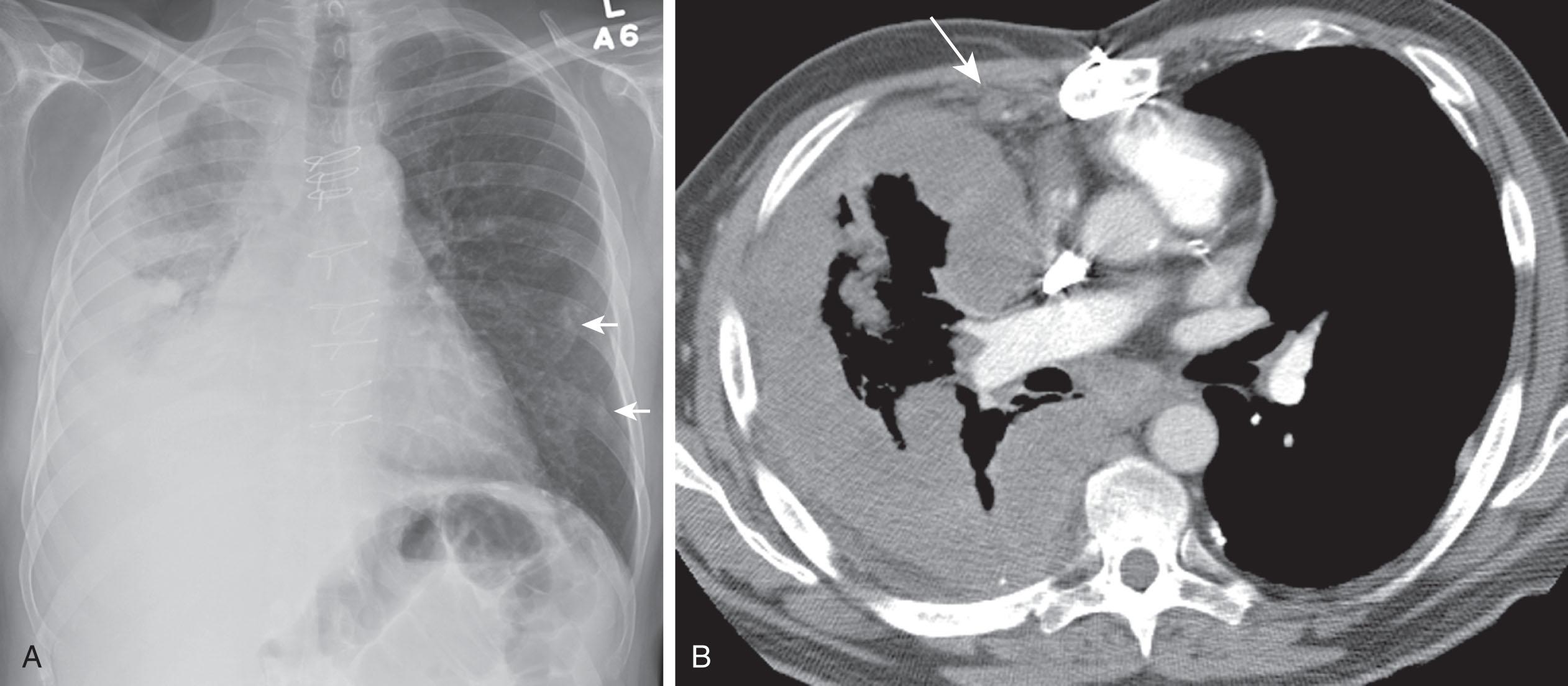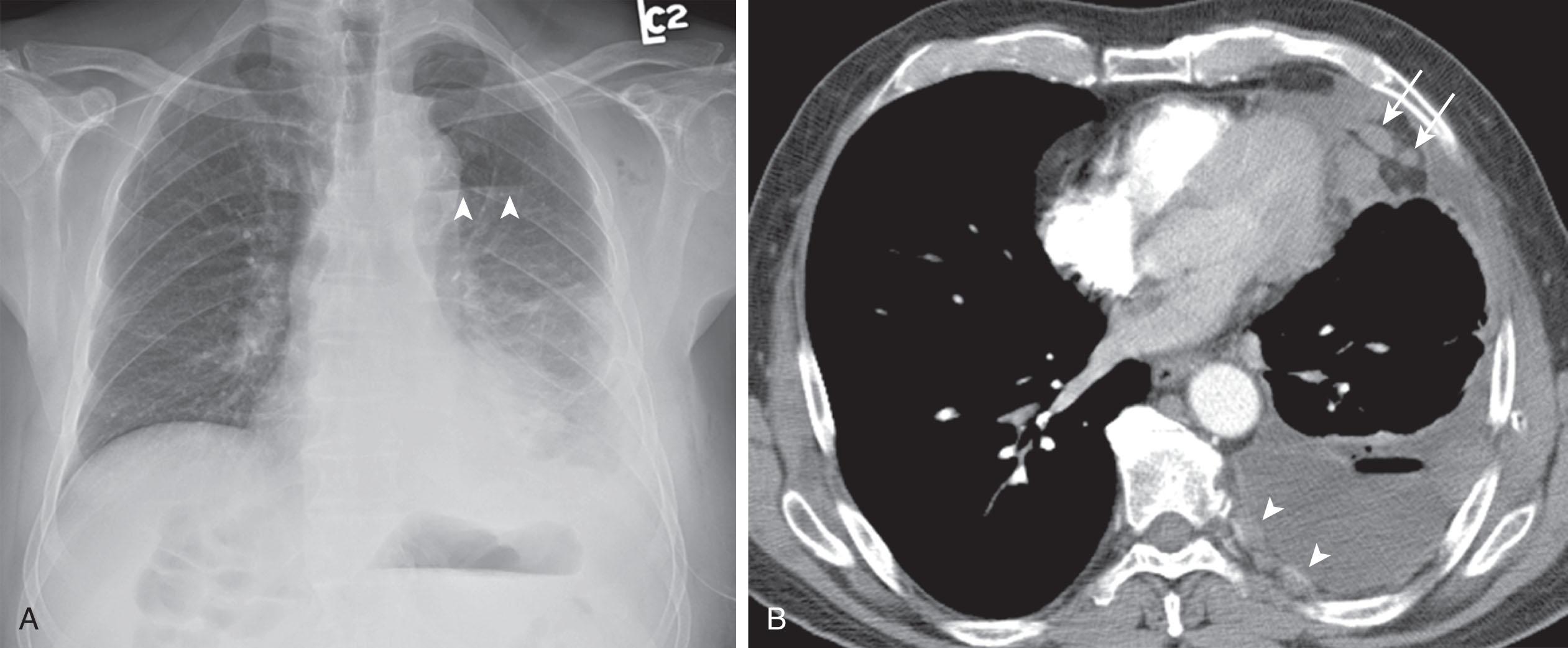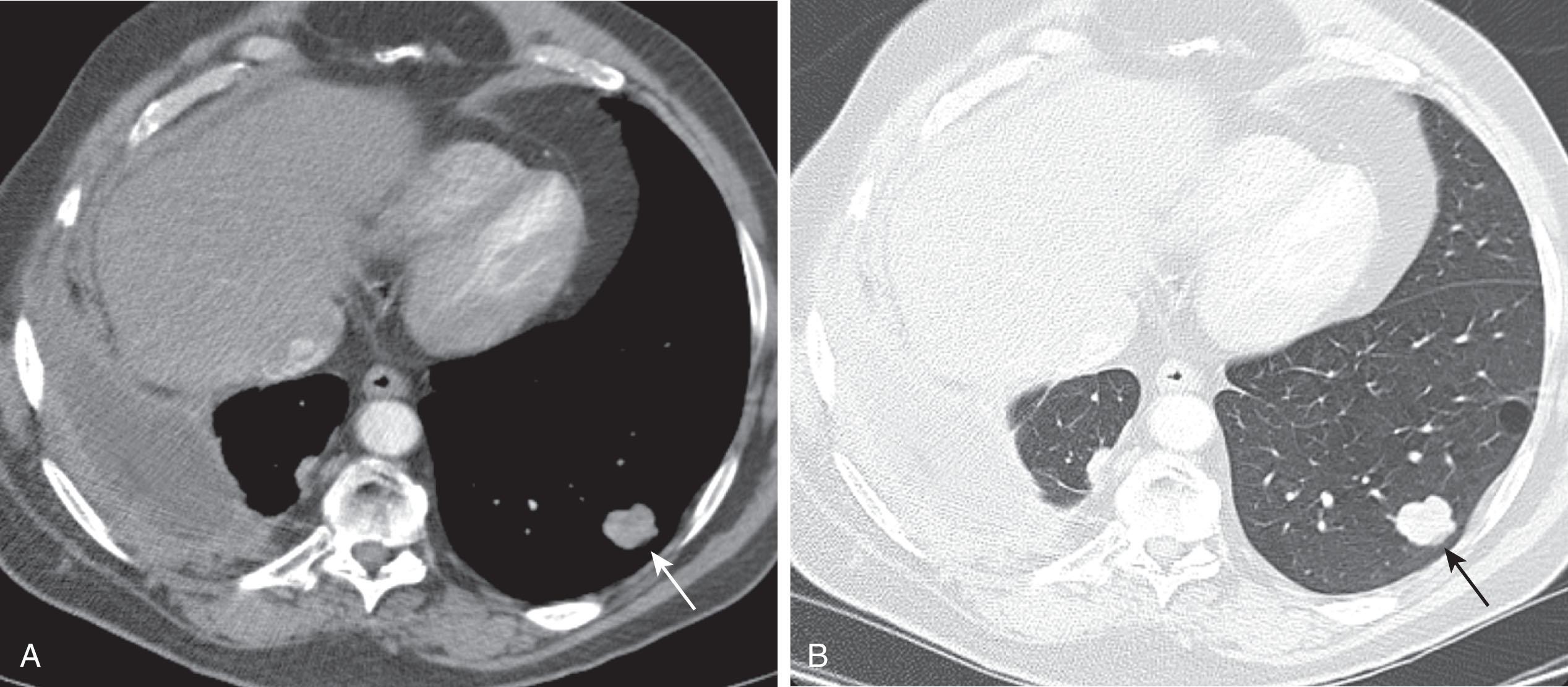Physical Address
304 North Cardinal St.
Dorchester Center, MA 02124
Neoplasms of the pleura are a diverse group of benign and malignant pathologic entities that include both primary and secondary malignancies. Most neoplasms of the pleura are metastases, typically from lung cancer, although extrathoracic neoplasms such as breast and ovarian cancer have a predilection for spread to the pleura. This chapter discusses the most common primary malignant neoplasm to arise from the pleura, diffuse malignant pleural mesothelioma (MPM), with a comprehensive review of the imaging, staging evaluation, and treatment considerations for MPM. Imaging findings that are important in establishing the diagnosis are discussed, and computed tomography (CT), magnetic resonance imaging (MRI), and positron emission tomography (PET)/CT findings that need to be emphasized or clarified so that oncologists and surgeons can deliver appropriate care are addressed.
MPM is an uncommon neoplasm arising from mesothelial cells of the pleura. The annual incidence in the United States is 3000 cases. The worldwide figure is expected to increase in the coming decade owing to the patterns of occupational exposure to asbestos and a latency period of up to 50 years. There is currently no universally accepted standard therapy for MPM, and the prognosis is poor, with a median survival of 9 to 17 months after diagnosis. However, important advances in the treatment of patients with MPM have occurred over the past few years, including a unified staging system, novel targeted agents, improved radiation therapy techniques for local control, and decreased morbidity and mortality in patients who undergo curative surgical resection. Furthermore, multimodality regimens combining chemotherapy, radiotherapy, and surgery are being used more frequently because of the failure of single-modality therapy. In cases of limited disease, there has been an increasing tendency to perform surgical resection as part of the treatment algorithm. Extrapleural pneumonectomy (EPP), the removal of the visceral and parietal pleura, ipsilateral lung, hemidiaphragm, and part of the pericardium, is the surgical treatment of choice in the 10% to 15% of patients who present with resectable disease and is reported to prolong survival (74% 2-yr survival and 39% 5-yr survival). The greatest survival benefit in patients with MPM after EPP is seen in those with epithelial histology, a primary tumor that is limited in extent, and no nodal metastases. Conversely, patients with sarcomatoid histology and nodal metastases have a poor survival benefit after EPP and are typically primarily treated with palliative chemotherapy.
MPM occurs more frequently in men than in women, at a ratio of 4:1; however, the incidence in women is increasing. Peak incidence occurs in the sixth to seventh decades of life and is associated with a history of occupational exposure to asbestos in 40% to 80% of patients. In asbestos workers, the incidence of MPM is 10%. In contrast, the incidence of MPM in the general population is lower, estimated at 0.01% to 0.24%.
Asbestos, a collective term for a group of complex hydrated silicates, has varying degrees of carcinogenicity. MPM develops after a latent period of up to 50 years from the time of exposure to asbestos. There are two principal forms of asbestos: long, thin fibers known as amphiboles (amosite and crocidolite) and serpentine fibers known as chrysotile. The exposure-specific risk of MPM from the three principal commercial asbestos types is approximately 1:100:500 for chrysotile, amosite, and crocidolite. Chrysotile accounts for approximately 80% of the asbestos used in the Western world. Occupations at highest risk include insulation work, asbestos production and manufacture, the heating industry, shipyard work, construction, and automotive brake-lining manufacture and repair.
Because 20% of MPM patients have not been exposed to asbestos, alternative factors are presumed to be involved. Simian virus 40 (SV40), a DNA virus, has been implicated as a cofactor in the etiology of MPM. SV40 nucleic acids have been documented in a proportion of MPM cases. This virus blocks tumor suppressor genes and is a potent oncogenic virus in human and rodent cells.
Molecular biologic features of angiogenesis in MPM are important in the development of novel therapeutic strategies. MPM cells produce many growth factors such as epidermal growth factor, platelet-derived growth factor (PDGF), and transforming growth factor–β. MPM expresses the highest known levels of vascular endothelial growth factor (VEGF) of any solid tumor. VEGF expression in MPM is associated with poor survival and is now considered to be an independent prognostic factor in MPM. There is a positive correlation between VEGF expression and tumor stage ( P < .05). VEGF inhibitors have been shown to reduce MPM growth in animal models. Studies on the use of antiangiogenesis agents to target the VEGF pathway are ongoing. These agents include PTK787, an inhibitor of the PDGF/VEGF pathway, and bevacizumab, a recombinant human anti-VEGF monoclonal antibody. Genetic alterations in tumor suppressors such as p16, p14, and NF2 are common, and the activity of the antiapoptosis molecule Bcl-xL is elevated in MPM. Furthermore, MPM cells usually express telomerase, enabling them to develop resistance to anticancer drugs. In addition, interleukin-8, a potent chemokine with proangiogenetic activity, has been shown to be an autocrine growth factor in MPM cell lines.
The anatomy of the pleura is complex. The inferior margins of the pleura in the posterior costodiaphragmatic recesses of the hemithorax extend considerably lower than the corresponding border of the lung, to the level of the T12 vertebra. Macroscopically, the affected lung is covered by a thick layer of soft, gelatinous, grayish-pink tumor. Microscopically, MPM is classified into three histologic categories that provide a foundation for prognosis and therapy, forming a critical basis for epidemiologic and clinical studies. These categories are epithelial (55%–65%), sarcomatoid (10%–15%), and mixed or biphasic (20%–35%). The desmoplastic variant is considered a subtype of sarcomatous diffuse MPM. The epithelial type consists of cuboidal or polygonal cells with abundant pink cytoplasm and uniform round nuclei forming a tubular and papillary structure. The sarcomatoid or mesenchymal type of MPM consists of sheets of spindle cells of variable size, cellularity, and pleomorphism. The mixed type of MPM contains both epithelial and sarcomatoid patterns. The World Health Organization (WHO) classification requires that 10% or more of each component be present to fit the classification of biphasic. Special features of MPM include positive staining for acid mucopolysaccharide, strong staining for keratin proteins, and, on electron microscopy, the presence of long microvilli and abundant tonofilaments but the absence of microvillous rootlets and lamellar bodies. To differentiate epithelial MPM from adenocarcinoma, immunohistochemistry panels are useful. Epithelial MPM cells are positive for certain keratin proteins (AE1/AE3, CK5/6, CK7), calretinin, WT-1, D2–40, HBMe1, mesothelin, and thrombomodulin and negative for many markers including pCEA, TTF1, CD15(Leu-M1), BerEp4, B72.3, BG-8, and MOC-31. In contrast, immunohistochemistry is less helpful in sarcomatoid diffuse MPM.
Cytologic evaluation of pleural fluid (26% sensitivity) and needle aspiration biopsy (20.7% sensitivity) are inadequate to diagnose MPM. If tumor cells are present, distinguishing MPM from metastatic adenocarcinoma or severe atypia can be difficult. In contrast, image-guided core needle biopsy to obtain larger tissue samples has been shown to improve diagnostic accuracy (77% with ultrasound guidance and 83% with CT guidance). When a larger diagnostic specimen is needed, Cope needle biopsy, video-assisted thoracoscopic surgery (VATS), or open biopsy is performed. VATS has a diagnostic rate of 98% and is becoming the preferred method of diagnosis. However, this procedure has two disadvantages: the visceral and parietal layers of the pleura must not be adherent, and chest wall seeding occurs in up to one-half of patients. In contrast, chest wall seeding occurs in 22% of image-guided biopsies. To prevent tumor growth within biopsy sites, trocar ports, thoracoscopic tracts, and chest tube tracts, patients undergoing EPP typically have these tracts resected. In addition, local radiation therapy can be used to prevent chest wall seeding.
Malignant pleural mesothelioma (MPM) involves parietal and visceral pleural surfaces and extends into the interlobar fissures, along the diaphragm, mediastinum, and pericardium.
Tumor can invade lung and peritoneum.
MPM is divided into three histologic categories: epithelial (55%–65%), sarcomatoid (10%–15%), and mixed or biphasic (20%–35%).
Patients with MPM typically present with insidious onset of chest pain, shortness of breath, and cough. Invasion of the chest wall can lead to intractable pain. Pleural effusion is present in up to 95% of cases. As the tumor grows, there is complete infiltration of the pleura and encasement of the lung. Mediastinal invasion can lead to dysphagia, phrenic nerve paralysis, cardiac tamponade, and superior vena cava syndrome.
MPM spreads by contiguity over the parietal and visceral pleural surfaces, along the diaphragm, mediastinum, and pericardium, and possibly into the peritoneum. MPM can involve the interlobar fissures and invade the lung directly or by interstitial and alveolar spread. MPM is usually associated with a pleural effusion and can present with direct invasion of thoracic structures. The initial diagnosis of diffuse MPM requires demonstration of tumor invasion, most often into the parietal pleural fibrous tissue, extrapleural adipose tissue, or soft tissues of the chest wall.
Lymphatic dissemination is common, and mediastinal nodes are involved in 50% of cases. To understand the lymphatic spread of MPM, it is essential to examine the complex lymphatic drainage system of the pleura. The visceral pleural lymphatics follow the same drainage pattern as the lungs. However, the parietal pleural lymphatic drainage system is different. The anterior parietal pleura drains into the internal mammary lymph nodes ( Fig. 9.1 ). The posterior parietal pleura drains into the extrapleural/intercostal lymph nodes, which are located in the paraspinal fat adjacent to the heads of the ribs ( Fig. 9.2 ). The anterior and lateral diaphragmatic lymphatics drain into the internal mammary and anterior diaphragmatic lymph nodes. The posterior diaphragm drains into the paraaortic and posterior mediastinal lymph nodes. There are free anastomoses between lymphatics on both surfaces of the diaphragm, including the retrocrural, inferior phrenic, and gastrohepatic space, and the region of the celiac axis.


Distant hematogeneous metastases are common and can involve the lungs, liver, spleen, adrenals, lymph nodes, bones, and brain ( Fig. 9.3 ). Extrathoracic metastatic disease has been documented at autopsy in 50% to 80% of cases.
Local spread involves the parietal and visceral pleura and extends to interlobar fissures and along the diaphragm, mediastinum, and pericardium.
Owing to the complex drainage system of the pleura, evaluation of nodal disease in the extrapleural/intercostal, internal mammary, diaphragmatic, and upper abdominal regions is essential.
Mediastinal nodal disease is seen in 50% of cases.
Transdiaphragmatic invasion can result in spread to the peritoneum, liver, and spleen.
Hematogeneous dissemination is observed in 50% to 80% of cases at autopsy.

Multiple staging systems have been proposed for MPM. In an attempt to distinguish patients who would benefit from surgical resection from those needing palliative treatment, the International Mesothelioma Interest Group (IMIG) staging system for MPM was proposed and is gaining universal acceptance ( Tables 9.1 and 9.2 ). This system describes the extent of tumor according to a traditional tumor-node-metastasis (TNM) classification: local extent of the primary tumor (T descriptor), the presence and location of lymph node involvement (N descriptor), and the presence or absence of distant metastatic disease (M descriptor) ( Figs. 9.4 and 9.5 ). This system stratifies patients into categories with similar prognoses in an effort to select homogeneous groups of patients for entry into clinical trials to better assess new treatment options. Primarily to identify patients who are potentially resectable, this staging system uses criteria to determine the extent of local tumor and regional lymph node status, two factors that have been shown to be related to overall survival rate. The presence of advanced locoregional primary tumor (T4), N2–N3 disease (mediastinal, internal mammary, and supraclavicular lymph nodes), and M1 disease preclude surgery. However, staging using imaging modalities such as CT, MRI, and PET has limitations. This limitation, together with the morbidity and mortality associated with EPP, has resulted in the need for extended surgical staging (ESS) in patients being evaluated for resection. In our institution, cervical mediastinoscopy or endobronchial ultrasound-guided lymph node biopsy, laparoscopy, and peritoneal lavage are routinely performed in MPM patients undergoing preoperative evaluation. Rice and coworkers reported that ESS excluded 15 of the 118 patients (12.7%) assessed by clinical staging alone as candidates for EPP.
| T—Primary Tumor | |
| T1 | Tumor involving the ipsilateral parietal pleura (including mediastinal and diaphragmatic pleura) with or without involvement of visceral pleura |
| T2 | Tumor involving each ipsilateral pleural surface with at least one of the following features:
|
| T3 | Locally advanced but potentially resectable tumor. Tumor involving all of ipsilateral pleural surfaces with at least one of the following:
|
| T4 | Locally advanced, technically unresectable tumor. Tumor involving all of ipsilateral pleural surfaces with at least one of the following:
|
| N—Lymph Nodes | |
| NX | Regional lymph nodes not assessable |
| N0 | No regional lymph node metastases |
| N1 | Metastases in ipsilateral bronchopulmonary, hilar, or mediastinal lymph nodes (including the internal mammary, peridiaphragmatic, pericardial fat pad, or intercostal lymph nodes) |
| N2 | Metastases in the contralateral bronchopulmonary, hilar, or mediastinal lymph nodes or ipsilateral or contralateral supraclavicular lymph nodes |
| M—Metastases | |
| MX | Distant metastases not assessable |
| M0 | No distant metastases |
| M1 | Distant metastases present |
| STAGE | DESCRIPTION |
|---|---|
| IA | T1N0M0 |
| IB | T2N0M0; T3N0M0 |
| II | T1N1M0; T2N1M0 |
| IIIA | T3N1M0 |
| IIIB |
|
| IV | Any T, any N, M1 |
![Figure 9.4, Cross-section ( A – D ) and illustration ( E – H ) of the local extent of the primary tumor (T descriptor) in the tumor-node-metastasis classification of malignant pleural mesothelioma. Axial computed tomography (CT) with soft tissue window ( A ) and illustration ( E ) of a T1 tumor involving the ipsilateral parietal pleura (including mediastinal and diaphragmatic pleura) with or without involvement of visceral pleura ( arrows ). Axial CT with lung window ( B ) and illustration ( F ) of a T2 tumor involving each ipsilateral pleural surface with confluent visceral pleural tumor including fissures ( arrows ) or extension of tumor from visceral pleura into underlying pulmonary parenchyma or involvement of diaphragmatic muscle. Axial fused 2-[ 18 F] fluoro-2-deoxy-D-glucose positron emission tomography/CT ( C ) and illustration ( G ) of a T3 locally advanced but potentially resectable tumor. Tumor is involving all ipsilateral pleural surfaces with a solitary, completely resectable focus of tumor extending into soft tissues of chest wall ( arrow ). Coronal reformat CT with soft tissue window ( D ) and illustration ( H ) of a T4 locally advanced technically unresectable tumor. Tumor is involving all ipsilateral pleural surfaces with direct transdiaphragmatic extension of tumor to peritoneum ( arrow ) and thoracic spine ( arrowhead ). Figure 9.4, Cross-section ( A – D ) and illustration ( E – H ) of the local extent of the primary tumor (T descriptor) in the tumor-node-metastasis classification of malignant pleural mesothelioma. Axial computed tomography (CT) with soft tissue window ( A ) and illustration ( E ) of a T1 tumor involving the ipsilateral parietal pleura (including mediastinal and diaphragmatic pleura) with or without involvement of visceral pleura ( arrows ). Axial CT with lung window ( B ) and illustration ( F ) of a T2 tumor involving each ipsilateral pleural surface with confluent visceral pleural tumor including fissures ( arrows ) or extension of tumor from visceral pleura into underlying pulmonary parenchyma or involvement of diaphragmatic muscle. Axial fused 2-[ 18 F] fluoro-2-deoxy-D-glucose positron emission tomography/CT ( C ) and illustration ( G ) of a T3 locally advanced but potentially resectable tumor. Tumor is involving all ipsilateral pleural surfaces with a solitary, completely resectable focus of tumor extending into soft tissues of chest wall ( arrow ). Coronal reformat CT with soft tissue window ( D ) and illustration ( H ) of a T4 locally advanced technically unresectable tumor. Tumor is involving all ipsilateral pleural surfaces with direct transdiaphragmatic extension of tumor to peritoneum ( arrow ) and thoracic spine ( arrowhead ).](https://storage.googleapis.com/dl.dentistrykey.com/clinical/PleuralTumors/3_3s20B9780323695381000094.jpg)
![Figure 9.5, Cross-section ( A – B ) and illustration ( C ) of nodal disease spread (N descriptor) in the tumor-node-metastasis classification of malignant pleural mesothelioma. Axial computed tomography (CT) with soft tissue window ( A ); N1 denotes metastases in the ipsilateral bronchopulmonary, hilar, or mediastinal ( arrow ) lymph nodes (including the internal mammary, peridiaphragmatic, pericardial fat pad, or intercostal lymph nodes). Axial fused 2-[ 18 F] fluoro-2-deoxy-D-glucose positron emission tomography/CT ( B ); N2 denotes metastases in the contralateral bronchopulmonary, hilar, or mediastinal ( arrow ) lymph nodes or ipsilateral or contralateral supraclavicular lymph nodes. Figure 9.5, Cross-section ( A – B ) and illustration ( C ) of nodal disease spread (N descriptor) in the tumor-node-metastasis classification of malignant pleural mesothelioma. Axial computed tomography (CT) with soft tissue window ( A ); N1 denotes metastases in the ipsilateral bronchopulmonary, hilar, or mediastinal ( arrow ) lymph nodes (including the internal mammary, peridiaphragmatic, pericardial fat pad, or intercostal lymph nodes). Axial fused 2-[ 18 F] fluoro-2-deoxy-D-glucose positron emission tomography/CT ( B ); N2 denotes metastases in the contralateral bronchopulmonary, hilar, or mediastinal ( arrow ) lymph nodes or ipsilateral or contralateral supraclavicular lymph nodes.](https://storage.googleapis.com/dl.dentistrykey.com/clinical/PleuralTumors/4_3s20B9780323695381000094.jpg)
Become a Clinical Tree membership for Full access and enjoy Unlimited articles
If you are a member. Log in here